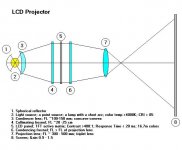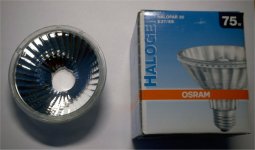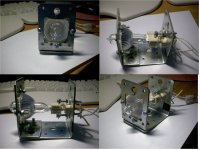so with a software that lets you manually connect the WDM filters to 'build the graph'
What are WDM Filters?
Did some reasarch and found Zoom player accepts directshow.
There is also Sonic Cineplayer dvd player
What about ffdshow filters? Do they have a mirror filter option?
Like I wrote you can (as Brainchild did) turn the TFT panel over and use it the other way which effectively mirrors the image. However, if it's designed to be used one way it's quite logical to assume that the other direction isn't recommended. For an example there may be heat problems. Also if you dismantle a monitor like the BenQ FP567s the electronics (pcb's) come out such way that it's easier to use the panel in it's original position (regarding the position of the light source).
The Directshow filters are WDM (windows driver model) filter drivers. The older standard (now obsolete) for video in Windows was (surprise) Video for Windows (VFW), and these are not compatible. When you open video (or audio) device in Windows (practically some application) the WDM filter graph is built automatically by the application. With Zoom player you can also manually add new filters (like the mirror filter) into the graph (between some other filters, all codecs like DivX or DVD are also filters, it's 'WDM language', look for Windows DDK or DirectX DDK in Microsoft.com site for all used terms).
The Directshow filters are WDM (windows driver model) filter drivers. The older standard (now obsolete) for video in Windows was (surprise) Video for Windows (VFW), and these are not compatible. When you open video (or audio) device in Windows (practically some application) the WDM filter graph is built automatically by the application. With Zoom player you can also manually add new filters (like the mirror filter) into the graph (between some other filters, all codecs like DivX or DVD are also filters, it's 'WDM language', look for Windows DDK or DirectX DDK in Microsoft.com site for all used terms).
mhelin
I have the fresnel (different focal lengths) and the tripet lens from diylabs. I have a NEC 1545v that I have disassembled and I use a 400W MH full size bulb. I am interested in splitting my fresnel, but am unsure of the distances between the different parts. I do not have a condensor lens. What distances should work best if I split the fresnel lens?
Someone please give me a definition of a condensor lens. I assume that a condensor lens takes the light souce on one side and makes it appear smaller and brighter to the fresnel lens. Is this true? Can someone explain the principle and how it results in a brighter image?
Mavmesa
I have the fresnel (different focal lengths) and the tripet lens from diylabs. I have a NEC 1545v that I have disassembled and I use a 400W MH full size bulb. I am interested in splitting my fresnel, but am unsure of the distances between the different parts. I do not have a condensor lens. What distances should work best if I split the fresnel lens?
Someone please give me a definition of a condensor lens. I assume that a condensor lens takes the light souce on one side and makes it appear smaller and brighter to the fresnel lens. Is this true? Can someone explain the principle and how it results in a brighter image?
Mavmesa
Easy Colour Correction
Have just been experimenting with different bulbs, some of which have an orange or blue tint and have thought of a very easy way to correct this - by painting the wall a slightly off white colour.
For example if your bulb looks slightly orange then painting the wall a very light turquoise colour should correct this for you as more blue and a bit more green will be reflected than red.
Clearly this is going to make the projected image slightly dimmer as less light will be reflected but it should be easier and cheaper (in true DIY fashion) than using colour correcting gels.
Just a thought anyway.
Steve
Have just been experimenting with different bulbs, some of which have an orange or blue tint and have thought of a very easy way to correct this - by painting the wall a slightly off white colour.
For example if your bulb looks slightly orange then painting the wall a very light turquoise colour should correct this for you as more blue and a bit more green will be reflected than red.
Clearly this is going to make the projected image slightly dimmer as less light will be reflected but it should be easier and cheaper (in true DIY fashion) than using colour correcting gels.
Just a thought anyway.
Steve
Or you can use a color filter infront of your lens or somewhere inside your projector. There are a lot more choices of colors and suttle colors to choose from. If you really got a lot of light you can even use contrast filters to increase contrast. There are color enhancing filters to give you richer and more saturated colors.
www.rosco.com (look for roscolux)
www.leefilters.com
They both have these swatch book sample kits which have samples of every filter in a small book. Some are big enough to use infront of your pj lens. The sample book is free. Go to a Movie lighting place in your town or a pro photo store where they sell lighting gells and they will have these. If you must have a larger sheet a 24"x24" sheet is about $5.
Panavision is a know movie shop chain that will most likely have them in your town.
www.rosco.com (look for roscolux)
www.leefilters.com
They both have these swatch book sample kits which have samples of every filter in a small book. Some are big enough to use infront of your pj lens. The sample book is free. Go to a Movie lighting place in your town or a pro photo store where they sell lighting gells and they will have these. If you must have a larger sheet a 24"x24" sheet is about $5.
Panavision is a know movie shop chain that will most likely have them in your town.
Re: The proven design
Here is a picture for my older
message (can't edit it for some reason). I can't recommended any other design, you can use fs mirror but you don't have to - the image can be flipped with software like Zoom Player Professional (needs DirectX 9). Also the split fresnel shouldn't be an issue anymore as diylabs.org is selling 12.2"x 12.2" fresnel with FL of 8.6" / 13" pre-split. With split one (two separate fresnels) you get MUCH brighter and evenly bright image and MUCH better colors. New TFT's just don't work well unless the light beam hits the panel in 90 degrees angle (~light rays are collimated). PLUS++ you can easily implement a small keystone correction by tilting the second fresnel, and get the projector out of view (keystone correction can be horizontal and vertical at the same time, so the projetor can reside for an example on the floor on one side wall of the room leaving plenty of room for the audience).
Here is a picture for my older
message (can't edit it for some reason). I can't recommended any other design, you can use fs mirror but you don't have to - the image can be flipped with software like Zoom Player Professional (needs DirectX 9). Also the split fresnel shouldn't be an issue anymore as diylabs.org is selling 12.2"x 12.2" fresnel with FL of 8.6" / 13" pre-split. With split one (two separate fresnels) you get MUCH brighter and evenly bright image and MUCH better colors. New TFT's just don't work well unless the light beam hits the panel in 90 degrees angle (~light rays are collimated). PLUS++ you can easily implement a small keystone correction by tilting the second fresnel, and get the projector out of view (keystone correction can be horizontal and vertical at the same time, so the projetor can reside for an example on the floor on one side wall of the room leaving plenty of room for the audience).
Attachments
dracul said:Will the mv directshow filter work with a tv tuner software and card?
I couldn't get the mv filter work at all. Use Dscaler for TV and Zoom Player for everything else.
You paid for the mv directshow filter and it didnt work?
How are you finding the quality of dscaler?
You have to buy or use zoom player pro to use with dvd right? Also, I need a directx9 compatible video card which start at $100 usd right?
How are you finding the quality of dscaler?
You have to buy or use zoom player pro to use with dvd right? Also, I need a directx9 compatible video card which start at $100 usd right?
I used the free demo version, for some reason MV Mirror didn't show to ZP. ZP Pro costs just $19.95, DirectX 9 cards start from 75 EUR (the crippled FX5200, or an ATI Radeon 9000 card). I'm not 100% sure if you need Dx9 card or is it enough if you just have DirectX 9 runtime installed. Anyway you must be able to use VMR9. There's nothing wrong with Dscaler, the quality is as good as the quality of your TV card, and much better than with the TV software that comes with those TV cards. Just enable the comb filter and 3:2 pulldown and adjust the colors, and enable the Mirror filter if you have a pj that needs it.
A replay to Faites777, I did a test with a big Halopar 30. I cut it and placed my hid-lamp in the middle. I´m sorry to say it didn´t work, becaurse the lamp only lights up the middle of the 15" tft, with the 30 degrees lamp and there aren´t any wider degrees for that lamp.
Attachments
In my pj design I instead use a 60 degrees small halogen bulb with coollight reflector. I cut it and placed my hid-lamp in the middle. And it works great ! Very bright with only 150 W. And becaurse the coollight reflector, you can almost run it with no fans.
Attachments
I think...
2 anglesteel $2.
2 Halogenholder GY6.35 $8. (Don´t need if you have a HID-holder).
1 Halogenbulb 35W 60 degree coollight $6.
Some screws from my junkbox. And of course you need a drillmachine, jigsaw and a glascuter, but that is normal things most people already have. So around $16, I think I spend to make it.
2 anglesteel $2.
2 Halogenholder GY6.35 $8. (Don´t need if you have a HID-holder).
1 Halogenbulb 35W 60 degree coollight $6.
Some screws from my junkbox. And of course you need a drillmachine, jigsaw and a glascuter, but that is normal things most people already have. So around $16, I think I spend to make it.
Ok. What happened to Brainchild?
He reported that the diopter he tested worked great he just had to make another box. I asked him what the diameter of the diopter was and the guy disappers. I will be receiving a 80mm diameter pj lens but I can only find 65mm diopters. Can someone tell me if this is gonna work before I buy it? Will the light not be cut down at least if not the image itself?
What if I put it on the inside of the projector housing?
Has anyone else has success with this?
Is the image quality compromised?
He reported that the diopter he tested worked great he just had to make another box. I asked him what the diameter of the diopter was and the guy disappers. I will be receiving a 80mm diameter pj lens but I can only find 65mm diopters. Can someone tell me if this is gonna work before I buy it? Will the light not be cut down at least if not the image itself?
What if I put it on the inside of the projector housing?
Has anyone else has success with this?
Is the image quality compromised?
Split fresnel improvement?
mhelin
I have redesigned my projector, split my fresnel into 2 parts, and duplicated your layout (except for the condensor and the reflector). I do have the 80mm triple, and the 8.8/13 fresnel from diylabs. I cannot get any increase in brightness nor does the lighting even out anymore than before.
Please give me the distances between your optical components so that I can duplicate your setup "exactly" and see if there are any benefits to splitting the fresnel.
Mavmesa
mhelin
I have redesigned my projector, split my fresnel into 2 parts, and duplicated your layout (except for the condensor and the reflector). I do have the 80mm triple, and the 8.8/13 fresnel from diylabs. I cannot get any increase in brightness nor does the lighting even out anymore than before.
Please give me the distances between your optical components so that I can duplicate your setup "exactly" and see if there are any benefits to splitting the fresnel.
Mavmesa
mavmesa,
What type of panel you use? It is possible that some LCD's (like my dismantled FP567s) absolutely require two fresnels (collimated, straight light rays though the panel). My distances are ~8.8" from the bulb to the 1st fresnel, the second fresnel is next to panel, tilted for keystone correction, distance between LCD and pj lens is about 10"-12" (I use the shorter FL pj triplet from diylabs, same frensel as you). Check that you have the grooves of fresnels inside.
What type of panel you use? It is possible that some LCD's (like my dismantled FP567s) absolutely require two fresnels (collimated, straight light rays though the panel). My distances are ~8.8" from the bulb to the 1st fresnel, the second fresnel is next to panel, tilted for keystone correction, distance between LCD and pj lens is about 10"-12" (I use the shorter FL pj triplet from diylabs, same frensel as you). Check that you have the grooves of fresnels inside.
I think we can't improve anymore this design. Though I'm happy with mine I'd like to use a smaller (~150W) bulb but there are no wonder reflectors or condencers available that could make it possible to use 100% of light for projection. There are only small improvements to be made, maybe 10% brighter image with better quality components (or with less components like without mirror). Maybe in future there will be LCD's that let more light through when ON and less when OFF improving both contrast and brightness. Till that day nothing can be done to make things better.
Btw. I've seen TFT monitors (17") with 800:1 CR, how would that be? Sanyo PLV-Z2 will have CR of 1300:1 even when it's LCD and not DLP.
Btw. I've seen TFT monitors (17") with 800:1 CR, how would that be? Sanyo PLV-Z2 will have CR of 1300:1 even when it's LCD and not DLP.
NEC 1550V
I am using the NEC 1550V. There is no discernable difference in light output. Possible our difference is that your panel is more picky about the angle of light entering it.
I will stay with the new design as it is more flexible. Since I have split the fresnel, I now have debris on the grooves and seem inable to remove it. Any ideas?
I am using the NEC 1550V. There is no discernable difference in light output. Possible our difference is that your panel is more picky about the angle of light entering it.
I will stay with the new design as it is more flexible. Since I have split the fresnel, I now have debris on the grooves and seem inable to remove it. Any ideas?
heat questions
I will be using a standard 400W MH bulb (BT37) in my DIYproj.
The bulb produces alot of heat and this is a concern for me.
I plan on using a glass plate to block the heat from reaching the LCD. Added on is a 92mm fan to pump the heat out of the enclosure. The only thing missing is an IR filter to eliminate the heat radiation(light).
1) Where can I get an IR filter that's 12''x12''? I plan to use automotive tint (<50%) since it's cheaper.
2) Do I really need all of this add-ons? Will the fresnel melt with only a fan in the system? Does the DIYLABS fresnel turns yellowish over time?
I will be using a standard 400W MH bulb (BT37) in my DIYproj.
The bulb produces alot of heat and this is a concern for me.
I plan on using a glass plate to block the heat from reaching the LCD. Added on is a 92mm fan to pump the heat out of the enclosure. The only thing missing is an IR filter to eliminate the heat radiation(light).
1) Where can I get an IR filter that's 12''x12''? I plan to use automotive tint (<50%) since it's cheaper.
2) Do I really need all of this add-ons? Will the fresnel melt with only a fan in the system? Does the DIYLABS fresnel turns yellowish over time?
- Home
- General Interest
- Everything Else
- The Moving Image
- DIY Projectors
- DIY Video Projector Part II


